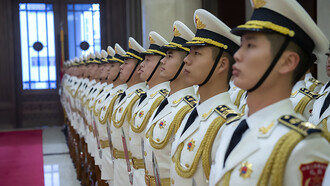Who, like me, witnessed the birth of the UN Convention on Biodiversity in Rio de Janeiro in May 1992 and has followed its performance over the last thirty years, as reflected in the successive COPs (Conference of the Parties), cannot but observe each new COP (always with the glaring absence of the USA) with increasing distance and skepticism. By coincidence, I was in Cali, Colombia, during the period when COP 16 took place (second half of October). The purpose of my visit was to fraternize with some of the social movements that organized the great social explosion of resistance in 2021, in which I was involved, namely with Puerto Resistencia (formerly known as Puerto Rellena). This is where the anti-monument, Monumento a la Resistencia, was erected by the people in struggle, a sculpture built collectively, almost ten meters high, representing the hand of Kay Kimi Ktachi, the Mayan god of war, holding the sign "Resist." The monument has just been recognized by the Colombian government as a national monument, which may help protect it from the various attempts by right-wing and extreme right-wing forces to topple it.
COP 16 had in its favor the fact that it was being held in the country whose president has the most informed and demanding awareness of the imminent ecological collapse and where movements and organizations, both indigenous and Afro-descendant (Vice President Francia Marquez is Afro-descendant), have a suffering and reflective experience of the war of the current model of economic development against nature. Not surprisingly, the general theme of the COP was “Peace with Nature.”
If we look at the organizations from the global North that have participated in and dominated these types of meetings, it's easy to conclude that COP 16 was more of the same, since the priority has always been to preserve the continuity of global capitalism and to find new business opportunities in the ecological crisis. Compromises can be made, but they are more rhetorical than real. Some of them are an exercise in hypocrisy, such as replacing the term “carbon credits” with “nature credits." But as with other international events, the reality or effectiveness of COP16 cannot be reduced to what was officially (not) discussed and (not) decided.
It includes everything that took place or was made possible inside and outside the institutional frameworks. This was “the COP de la gente” [the people's COP] due to the massive participation of popular organizations and movements (the “green zone” of the COP), which used the COP to advance their national and international agendas. Indigenous and Afro-descendant movements and organizations were particularly active, and, within them, there was a notable participation of women. This is the case of the International Network of Indigenous Women on Biodiversity and the Network of Indigenous Women on Biodiversity for Latin America and the Caribbean.
On an institutional level, the greatest victory has certainly been the official recognition of the contribution of people of African descent to biodiversity conservation, which the Vice President of Colombia characterized as a historic measure of ethnic-racial justice. It's a measure with special symbolism since Cali is, after Salvador (Brazil), the largest black city in Latin America. This victory took place within the framework of the broader agreement on Article 8J of the Convention (traditional knowledge, innovations, and practices): the creation of a subsidiary body for indigenous peoples and local communities was approved, linking the protection of biodiversity to the protection of the local communities that care for it the most.
The most important thing was, however, the way in which the different social struggles were articulated to converge on demands that boosted their unity and visibility and built decisive bridges between biodiversity and bioculturalism. Thus, the Regional Convergence of the Colombian Pacific included black, Afro, Palenqueros, indigenous peoples, youth, women, peasant groups, various LGBTIQ+ organizations, local and urban communities, communal action councils, and academics. On an international level, and also at the initiative of the Vice President of Colombia, relations with the Caribbean countries and some African countries have deepened, including agreements to abolish visas between Colombia and Mozambique and Ghana.
The oppressed groups that modern Eurocentric domination (capitalist, colonialist, and patriarchal) has cast on the other side of the abyssal line, in colonial sociability, as I have proposed in the epistemologies of the South, have learned over centuries to experience these events with a hermeneutic of suspicion and therefore to participate with one foot inside and one foot outside the institutions imposed on them. Indigenous movements and organizations have been particularly ingenious in giving COP 16 its real name: COP 532. That is to say, the number of years of European colonialism in Abya Yala. Given that indigenous peoples make up no more than 6.2% of the world's population, how can we explain the fact that 80% of biodiversity is concentrated in their territories and in the territories of poor peasants?
If they have been the guardians of biodiversity for centuries, shouldn't they be in charge of the UN Convention on Biodiversity and proposing the necessary measures to save what has not yet been lost? Aren't they the experts? Why are these meetings run and organized according to the cultural matrix and in obedience to the interests of those who have been and continue to be most responsible for the destruction of biodiversity? These questions are outside the political debate allowed to circulate in the corridors of the COP. They belong to the civilizational debate with which indigenous peoples, Afro-descendants, and peasants want to condition the political debate, and they are doing so with increasing insistence. For this reason, the indigenous movements that promote the “Global Life Plan," while celebrating the victory in the context of Article 8J, consider it insufficient “because we, the peoples of the world, continue to fight for our original nationalities to have a voice and their own decision-making power on the global stage and as indigenous governments.”
The idea of COP 532 was to strengthen the legitimacy of the social struggles that are currently underway in Colombia. Three areas deserve particular mention: land, education, and the law. The struggle to reclaim land is ongoing throughout the region and particularly in the Cauca region, where the COP was held. The Movement of Indigenous Authorities of the South-West (AISO, acronym of the Spanish name) has been recovering thousands of hectares of land with the aim of promoting indigenous and peasant agriculture. In the area of education itself, the Misak, Nasa, and Pijaos peoples have been demanding that the Colombian government pay greater attention to intercultural educational processes.
The Taita (authority) Jesús Maria Aranda, from the Misak community, said that the aim of self-education was “to ensure that the life processes of the peoples last for future generations, which implies the existence of spaces for always and forever. The Misak University or Ala Kusrei ya Misak University is very important. Misak University will be articulated with the official education system in accordance with the principles of the Indigenous Education System and respects the original mandate and dignity of the peoples, under the terms of the Derecho Mayor [original indigenous law].”.
Taita Jesús’ quote bridges the gap with the third area of struggle: the recognition of the original indigenous law. This struggle is particularly topical today since, 33 years after it was established in the Political Constitution of 1991 (art. 246), the Colombian Congress is discussing the “coordination between the special indigenous jurisdiction and the national judicial system” through an inter-jurisdictional coordination bill. This bill has already been the subject of prior, free and informed consent in accordance with international law on indigenous peoples.
The law's objectives are broad: “To establish a roadmap that strengthens the recognition of indigenous peoples’ own justice systems and promotes authority-authority dialogue; to advance coordination scenarios with all the necessary support and legal certainty; to create a basis and general rules so that different forms of justice can work together. It is not intended to unify or make equal the justice systems of the country’s 115 indigenous peoples; always respect the autonomy and diversity of indigenous peoples, recognizing the cultural richness of the nation; compile the case law of the higher courts on how to coordinate indigenous justice with ordinary justice and the rules for determining when indigenous jurisdiction applies; establish compulsory language mediation and the training of interpreters; strengthen the duty of technical, scientific, and legal support between the authorities, operators, and collaborators of the National Judicial System and the authorities of indigenous peoples; strengthen the existing instances of coordination between indigenous justice and the national judicial system; meet and include the demands of the indigenous movement and the positions of judicial bodies.”
“All of these issues have been discussed and agreed in the National Commission for the Coordination of the Judicial System and Special Indigenous Jurisdiction (COCOIN), the main space for dialogue on the issue, together with the Permanent Consertation Table of Indigenous Peoples.” Nonetheless, it is to be expected that the approval of this bill will be particularly controversial and turbulent. But the truth is that Colombia, under the presidency of President Gustavo Petro, is the country in Latin America where indigenous peoples have the most reason to hope for the recognition of their self-determination and their right to their own land. This would be the highest achievement of COP 532.














